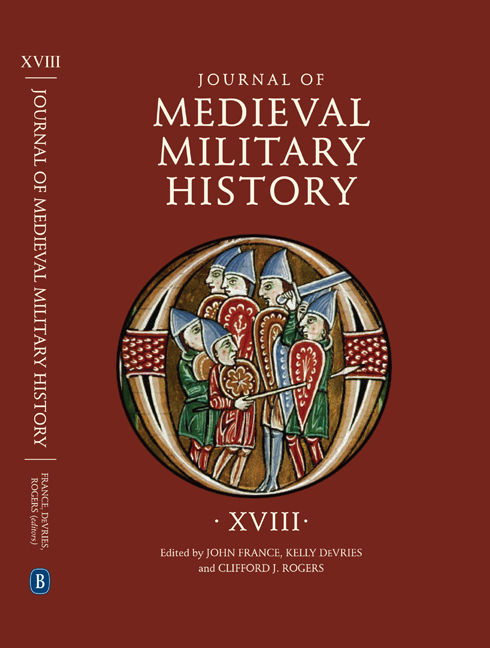Book contents
- Frontmatter
- Contents
- List of Illustrations
- 1 The Eastern Campaigns of King Henry II of Germany, 1003–17
- 2 Peace, Popular Empowerment and the First Crusade
- 3 The Transformation of Naval Warfare in Scandinavia during the Twelfth Century
- 4 Auxiliary Peoples and Military Reform on Hungary’s Western Frontier in the Thirteenth Century
- 5 What Types of Sources Did Medieval Chroniclers Use to Narrate Battles? (England and France, Twelfth to Fifteenth Centuries)
- 6 Experimental Tests of Arrows against Mail and Padding
- 7 Four Misunderstood Gunpowder Recipes of the Fourteenth Century
- 8 The Earliest Middle English Recipes for Gunpowder
- 9 Horses and Horsemen in Fifteenth-Century Siege Warfare, with Particular Reference to the Later Hundred Years War
- 10 Supplying the Army: The Siege of Pisa, 1499
- List of Contributors
- Journal of Medieval Military History 1477–545X
4 - Auxiliary Peoples and Military Reform on Hungary’s Western Frontier in the Thirteenth Century
Published online by Cambridge University Press: 06 October 2020
- Frontmatter
- Contents
- List of Illustrations
- 1 The Eastern Campaigns of King Henry II of Germany, 1003–17
- 2 Peace, Popular Empowerment and the First Crusade
- 3 The Transformation of Naval Warfare in Scandinavia during the Twelfth Century
- 4 Auxiliary Peoples and Military Reform on Hungary’s Western Frontier in the Thirteenth Century
- 5 What Types of Sources Did Medieval Chroniclers Use to Narrate Battles? (England and France, Twelfth to Fifteenth Centuries)
- 6 Experimental Tests of Arrows against Mail and Padding
- 7 Four Misunderstood Gunpowder Recipes of the Fourteenth Century
- 8 The Earliest Middle English Recipes for Gunpowder
- 9 Horses and Horsemen in Fifteenth-Century Siege Warfare, with Particular Reference to the Later Hundred Years War
- 10 Supplying the Army: The Siege of Pisa, 1499
- List of Contributors
- Journal of Medieval Military History 1477–545X
Summary
From 1283 to 1289, Duke Albert I of Habsburg was involved in several campaigns against the Kőszegi family in western Transdunabia. During these, he encountered Hungarian troops who still fought with the traditional tactics of steppe mounted archers. This article examines these campaigns to identify these Hungarian soldiers as, most likely, the descendants of Pechenegs who had settled in the region in earlier generations. Contemporary sources reveal both the strengths and the limitations of such troops, who posed serious problems for Duke Albert but could not ultimately block the success of his siege-oriented strategy in an area that had, since the time of the Mongol invasions, seen the widespread introduction of modern fortifications.
The ancient empires of the Middle East, the Greeks and Byzantines, the Romans and the Germanic states of the Middle Ages all encountered the Oriental strategy of nomad peoples with surprise. Many authors describe the fundamental difference between the Western and the Eastern armies as heavy shock cavalry versus light cavalry employing the famous stratagem of the feigned retreat, which involved the light cavalry falling back to lure the enemy into disorder, then turning to attack the surprised enemy. Their mounted archers employed a special tactic requiring years of training, when they leaned back in the saddle and shot their arrows at pursuing enemies, sometimes employing this tactic while circling around the enemy. This was one of their more unusual and feared tactics, but more broadly the victories of the nomads rested on more complicated military tactics and excellent leadership. Moreover, the warfare of the nomadic peoples was not monolithic: it had not only common features but also ethnic and historic differences over the course of centuries. One tactical commonality was the specially trained horses of the nomads. When they first arrived in the Danube basin, the Hungarians used their traditional military tactics, but later they also had to learn how to use the enemy's weapons and warfare as a part of their Western enculturation. However, for several centuries there was no shortage of soldiers who were capable of nomad military tactics because Oriental tribal groups kept arriving into the country.
- Type
- Chapter
- Information
- Journal of Medieval Military HistoryVolume XVIII, pp. 99 - 116Publisher: Boydell & BrewerPrint publication year: 2020

